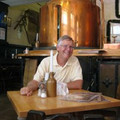的点评
A New Experience
Cranberry Museum的点评
点评:We didn’t know there was actually cranberry farming on the West Coast. But there is. Yes, the majority of cranberries are farmed in the East (with Wisconsin being the largest cranberry producer). There is enough cranberry farming in Washington that in the 1920s Washington State University began a cranberry research station. The station has morphed over the years and ownership has changed. But it still researches cranberry growing with emphasis on eliminating pests, increasing yield and more efficient harvesting. Along with the station, there’s a small museum (with attendant gift store almost as big as the museum) and demonstration field.
So, to the museum. It’s in a small house with the front end selling everything cranberry – cranberry T-shirts, cranberry jams and jellies, cranberry dolls, cranberry cookbooks, cranberry coffee cups, and of course, cranberries (dried). Off to the side is the two room museum. The museum concisely describes the research station and various developments in cranberry growing and harvesting. Actually a lot goes into growing cranberries. They are vines in sandy soil (not bogs). They like moisture, but not being flooded. That’s just for harvesting.
Outside are a number of cranberry quarter acre patches, each with its own purpose – experimenting with pest control, experimenting with different cranberry varieties, exploring the impact of Global Warming. The vines were full of cranberries, many seemingly ripe. There’s a harvest festival in mid-October. Looked like fun.
So, to the museum. It’s in a small house with the front end selling everything cranberry – cranberry T-shirts, cranberry jams and jellies, cranberry dolls, cranberry cookbooks, cranberry coffee cups, and of course, cranberries (dried). Off to the side is the two room museum. The museum concisely describes the research station and various developments in cranberry growing and harvesting. Actually a lot goes into growing cranberries. They are vines in sandy soil (not bogs). They like moisture, but not being flooded. That’s just for harvesting.
Outside are a number of cranberry quarter acre patches, each with its own purpose – experimenting with pest control, experimenting with different cranberry varieties, exploring the impact of Global Warming. The vines were full of cranberries, many seemingly ripe. There’s a harvest festival in mid-October. Looked like fun.
翻译:我们不知道西海岸实际上有蔓越莓种植。但确实有。是的,大多数蔓越莓种植在东部(威斯康星州是最大的蔓越莓产地)。华盛顿的蔓越莓种植已经足够多,以至于华盛顿州立大学在 20 世纪 20 年代开设了一个蔓越莓研究站。多年来,该站发生了变化,所有权也发生了变化。但它仍然在研究蔓越莓的种植,重点是消灭害虫、提高产量和提高收获效率。除了这个研究站,还有一个小博物馆(附带的礼品店几乎和博物馆一样大)和示范场。
所以,去博物馆吧。它位于一栋小房子里,前面卖着各种蔓越莓——蔓越莓 T 恤、蔓越莓果酱和果冻、蔓越莓娃娃、蔓越莓食谱、蔓越莓咖啡杯,当然还有蔓越莓(干的)。旁边是两个房间的博物馆。博物馆简要介绍了研究站和蔓越莓种植和收获的各种进展。实际上,种植蔓越莓需要很多东西。它们是沙质土壤(不是沼泽)中的藤蔓。它们喜欢潮湿,但不喜欢被水淹没。那只是为了收获。
外面有许多四分之一英亩的蔓越莓地块,每个地块都有自己的用途——试验害虫控制、试验不同的蔓越莓品种、探索全球变暖的影响。藤蔓上长满了蔓越莓,很多似乎已经成熟了。十月中旬有一个收获节。看起来很有趣。
所以,去博物馆吧。它位于一栋小房子里,前面卖着各种蔓越莓——蔓越莓 T 恤、蔓越莓果酱和果冻、蔓越莓娃娃、蔓越莓食谱、蔓越莓咖啡杯,当然还有蔓越莓(干的)。旁边是两个房间的博物馆。博物馆简要介绍了研究站和蔓越莓种植和收获的各种进展。实际上,种植蔓越莓需要很多东西。它们是沙质土壤(不是沼泽)中的藤蔓。它们喜欢潮湿,但不喜欢被水淹没。那只是为了收获。
外面有许多四分之一英亩的蔓越莓地块,每个地块都有自己的用途——试验害虫控制、试验不同的蔓越莓品种、探索全球变暖的影响。藤蔓上长满了蔓越莓,很多似乎已经成熟了。十月中旬有一个收获节。看起来很有趣。
此点评仅代表旅行者个人的主观意见,并不代表TripAdvisor以及其合作方的意见。
关于我们
|
新闻动态
|
商务合作
|
会员中心
|
业主中心
|
业主通
|
常见问题
|
意见反馈
|
联系我们
|
营业执照
© 2025 Tripadvisor 版权所有。
使用条款 |隐私政策 |网站工作原理
部分照片由 VFM Leonardo 提供。
* Tripadvisor不是旅行社,也不是旅游预订服务代理商。我们提供免费、客观、公正的旅游资讯服务。 (显示更多)
TripAdvisor LLC 既不是预订代理商,也不是旅游运营商,不会向网站用户收取任何服务费。 按照规定,在 Tripadvisor 发布机票价格、游览和旅行套餐的合作伙伴(航空公司、旅行提供商及预订代理商),其标价须包含所有费用和附加费用。 例如, 机场出入境税费、消费税与其他服务费、手续费、杂费及附加费用。 当您向我们的某个合作伙伴进行预订时,请务必查阅他们的网站以了解当地行政部门要求的所有适用费用的具体情况。 除非另有说明,机票价格通常指的是一个人的价格(以人民币计)。
为方便起见,TripAdvisor LLC 根据从我们的预订合作伙伴获取的空房率计算每个酒店的均价。 对于游览和景点来说,所显示价格通常是每位成人的最低可用价格。 对于列出的任何旅行套餐或优惠,TripAdvisor LLC 无法保证任何特定的费率或价格。 此外,酒店均价每晚会更新,并以您的首选币种表示(使用现行汇率)。 由于这些已换算的价格是预估价格,因此,有关具体金额和币种请与预订网站进行核实。
此外,TripAdvisor LLC 无法保证我们网站上宣传的价格随时有效。 标价可能需要预订一定天数才能生效,或有不可用日期、使用条件或限制。
TripAdvisor公司对外部网站的内容一概不负责。优惠价格中不含税和其他费用。
ICP证:沪B2-20200433
沪ICP备20013175号
 沪公网安备31010502005427号
沪公网安备31010502005427号鹰程信息技术(上海)有限公司
货币/国家及地区
¥CNY
中国

